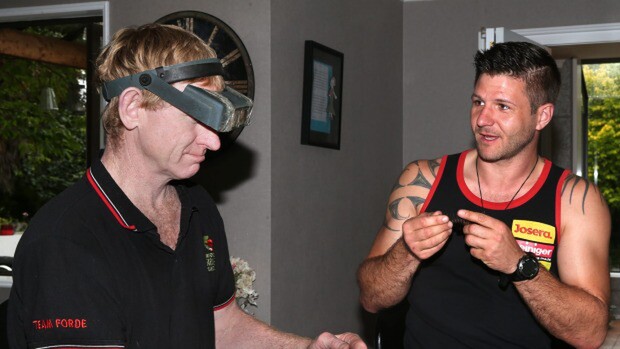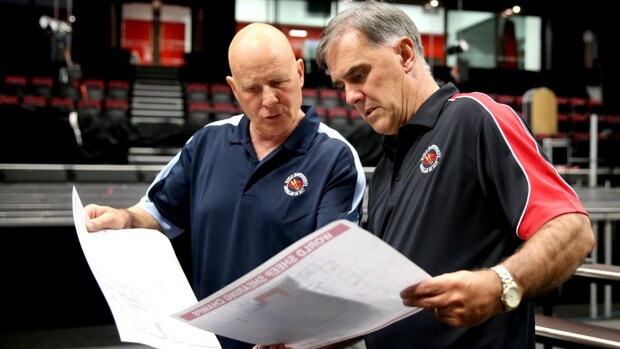Article and images courtesy of The Southland Times/Fairfax Media
A month out from the competition, competitors for the World Shearing and Woolhandling Championships are migrating south in preparation for the big event.
German team member Jan Juppe arrived in New Zealand on Christmas Day, but making it to New Zealand is a tale of hard work and determination.
Competing in the blade shearing, woolhandling and intermediate machine shearing, Juppe said he felt like competing in the championships was like coming full circle.
New Zealand Shearing Foundation chairman Tom Wilson and ILT Stadium Southland general manager Nigel Skelt plan the logistics of hosting the World Shearing and Woolhandling Championship next month.
Sick of sporting a suit and tie as steel salesman in Germany, Juppe swapped the shirt for a singlet and travelled to New Zealand in 2009, starting off as a lambing shepherd in the Waikaka Valley.
He worked his way up the ranks but in March last year suffered a neck injury, leaving his arms paralysed.
He had already qualified for the German team in 2015, and was determined to keep his spot, even after doctors told him he would never shear again.
"I'm a pretty stubborn German; I didn't do what they [doctors] told me," he said.
After therapy, he built up his physical and mental health but suffered another setback when he tore some tendons in his shoulders while wakeboarding.
"That threw me back in my training schedule for miles," he said.
Again, he picked himself back up and said he had come back even stronger than before his first injury.
Now working for Darin Forde in Lorneville, Juppe said the work was part of his training ahead of the championships.
"I need to get my footwork right, I need to get my pattern right ... This is the best place to learn anything about Southland sheep," he said.
A month out from the competition, competitors for the World Shearing and Woolhandling Championships are migrating south in preparation for the big event.
German team member Jan Juppe arrived in New Zealand on Christmas Day, but making it to New Zealand is a tale of hard work and determination.
Competing in the blade shearing, woolhandling and intermediate machine shearing, Juppe said he felt like competing in the championships was like coming full circle.
New Zealand Shearing Foundation chairman Tom Wilson and ILT Stadium Southland general manager Nigel Skelt plan the logistics of hosting the World Shearing and Woolhandling Championship next month.
Sick of sporting a suit and tie as steel salesman in Germany, Juppe swapped the shirt for a singlet and travelled to New Zealand in 2009, starting off as a lambing shepherd in the Waikaka Valley.
He worked his way up the ranks but in March last year suffered a neck injury, leaving his arms paralysed.
He had already qualified for the German team in 2015, and was determined to keep his spot, even after doctors told him he would never shear again.
"I'm a pretty stubborn German; I didn't do what they [doctors] told me," he said.
After therapy, he built up his physical and mental health but suffered another setback when he tore some tendons in his shoulders while wakeboarding.
"That threw me back in my training schedule for miles," he said.
Again, he picked himself back up and said he had come back even stronger than before his first injury.
Now working for Darin Forde in Lorneville, Juppe said the work was part of his training ahead of the championships.
"I need to get my footwork right, I need to get my pattern right ... This is the best place to learn anything about Southland sheep," he said.
Darin Forde and Jan Juppe check their shearing combs.
Meanwhile, at the event's venue, ILT Stadium Southland general manager Nigel Skelt and New Zealand Shearing Foundation chairman Tom Wilson were planning out the logistics of putting the event on in Southland.
With more than 4000 sheep making their way to the stadium, health and safety were the top priority and during the competition, with down-to-the-minute planning put in place to ensure the championships' events flowed well.
"It's more like a military operation," Wilson said.
The shearers would be on a stage 2 metres above the ground level, with the sheep being on stage only when a shearer pulled one out, and there would also be video screens on each side of the stage, showing the action at various angles.
The sheep would be trucked in from farms around Southland, the biggest foreseeable issue being keeping them dry if it rained during the competition.
If needed, coverings would be built to shield the sheep as they were moved from the transport truck into the stadium.
The stadium was one of the biggest venues to be used for the competition, as the shearing, woolhandling, industry expo and food court would be happening under one roof.
From fleece to garment, spectators would be able to see the entire process which made up the production of a wool product, Wilson said.
If someone had told Skelt 18 months ago the championships would be at the stadium, he would have looked very squarely at them, he said.
"If you want to create a nightmare, this is it," he said.
"But it's the most fantastic my team will ever create, and we can't wait to create it."
More than 30 countries have registered for the competition, which will take place over four days, starting on February 8.
Meanwhile, at the event's venue, ILT Stadium Southland general manager Nigel Skelt and New Zealand Shearing Foundation chairman Tom Wilson were planning out the logistics of putting the event on in Southland.
With more than 4000 sheep making their way to the stadium, health and safety were the top priority and during the competition, with down-to-the-minute planning put in place to ensure the championships' events flowed well.
"It's more like a military operation," Wilson said.
The shearers would be on a stage 2 metres above the ground level, with the sheep being on stage only when a shearer pulled one out, and there would also be video screens on each side of the stage, showing the action at various angles.
The sheep would be trucked in from farms around Southland, the biggest foreseeable issue being keeping them dry if it rained during the competition.
If needed, coverings would be built to shield the sheep as they were moved from the transport truck into the stadium.
The stadium was one of the biggest venues to be used for the competition, as the shearing, woolhandling, industry expo and food court would be happening under one roof.
From fleece to garment, spectators would be able to see the entire process which made up the production of a wool product, Wilson said.
If someone had told Skelt 18 months ago the championships would be at the stadium, he would have looked very squarely at them, he said.
"If you want to create a nightmare, this is it," he said.
"But it's the most fantastic my team will ever create, and we can't wait to create it."
More than 30 countries have registered for the competition, which will take place over four days, starting on February 8.
New Zealand Shearing Foundation chairman Tom Wilson and ILT Stadium Southland general manager Nigel Skelt plan the logistics of hosting the World Shearing and Woolhandling Championship next month.


